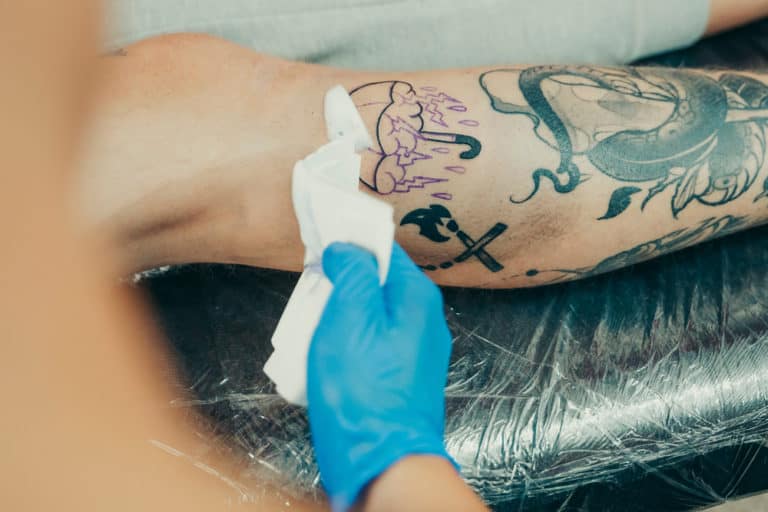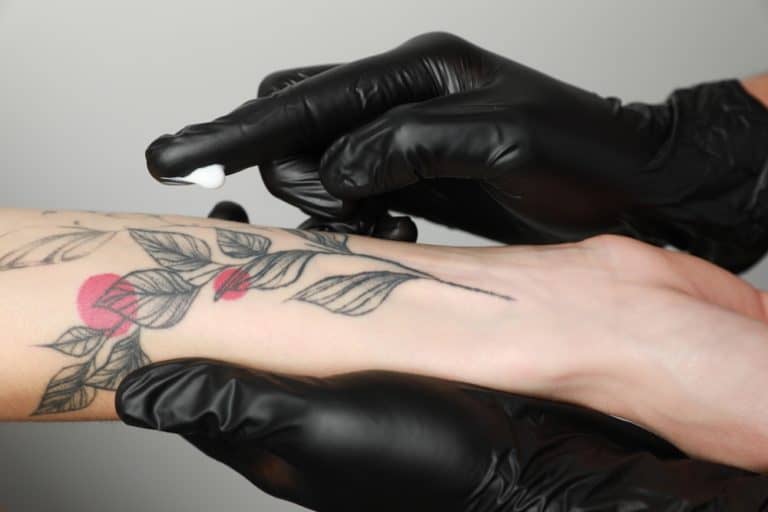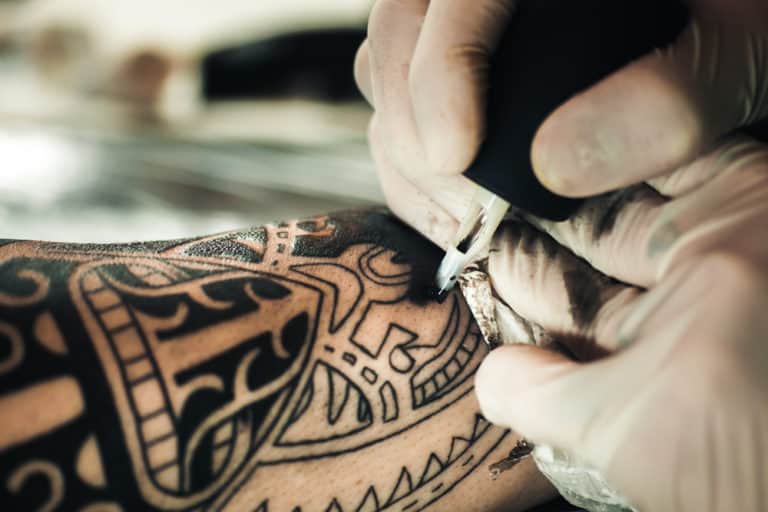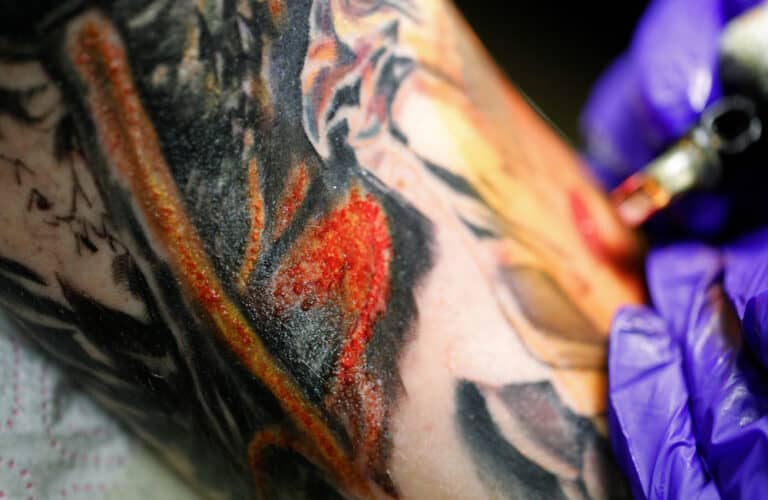Blackout Tattoo Aftercare: Everything You Need To Know
Blackout tattoos have seen a boom in popularity within the tattoo community over the last few years. Blackout tattoos may seem simple to get done, but they may be more work than you’d think! Like with any other tattoo, blackout tattoos require a lot of care during their aftercare period, so you’ll need to know what you’re in for.
A blackout tattoo is a tattoo that covers a large area of the body with a block of solid black ink. These tattoos usually take up to 6 months to heal, but the initial healing stages take around two weeks. Blackout tattoos require the same aftercare as others but can be more temperamental to heal.
So, what exactly is a blackout tattoo? And how is its aftercare any different from the aftercare for a normal tattoo? Our guide on blackout tattoo aftercare will help answer any questions you may have. If you’re interested in getting a blackout tattoo, this article is for you.
What Is A Blackout Tattoo?
The term ‘blackout tattoo’ describes a tattoo that completely covers a section or large area of the body in black ink. The most common areas for tattoo enthusiasts to get this solid black tattoo are the arms and the legs, but you can do it on almost any area of the body.
Blackout tattoos are generally used to cover up other tattoos, but this tattoo style has seen a surge in popularity in recent years. Because of the increase in popularity, some people have even started opting to get a blackout tattoo as a stand-alone tattoo.
Of course, the process of having a blackout tattoo is challenging and time-consuming, so you will need to be willing to commit to a tattoo like this one. If you want to fill in a bigger area of your body, you will need to be willing to book multiple sessions with your tattoo artist.
Your artist will also need to use more needles when pushing the ink into the skin, which means you will have to go through more pain than some other types of tattoos. Because blackout tattoos are solid, your tattoo artist will need to go over the area they are covering several times to achieve an even and saturated block of color.
How Long Does A Blackout Tattoo Take To Heal?
Because blackout tattoos vary in shape and size, they may sometimes have different healing times to other tattoos. While the initial healing stage will look like any other tattoo, a blackout tattoo covers a lot more surface area. The skin on this section of the body will have undergone a lot more trauma than it would if you had a simple fine linework tattoo done.
The initial scabbing and peeling stage of the healing process will last for around two weeks to a month after having the tattoo done, but it can take up to six months for your tattoo to heal completely.
The healing time of your blackout tattoo also depends on the part of your body that you have had tattooed. While some areas may heal quicker, you may find that areas of your body – like your hands or feet – will take longer to heal.
This is because these areas of your body are used more frequently than other areas. When you are tattooed, your skin undergoes trauma from being penetrated by the tattoo needles that push the ink underneath the skin.
Essentially, your tattoo can be considered an open wound until it has fully healed. Like other wounds, you should try your best to rest the area of your body that has been tattooed. But if your tattoo is somewhere that you can’t avoid using, you will be putting the tattoo under strain, thus prolonging the healing process.
Healing Stages Of A Blackout Tattoo
When you are healing your blackout tattoo, you will notice that it will undergo several stages. These stages include redness and possible oozing, itching, and peeling.
Once your artist has finished your tattoo, they will normally bandage it up before you leave the shop. It’s important that you only remove your bandage after the allotted time that they have suggested. In some cases, you may have to wait as little as an hour, while in others, you may have to wait up to a week before taking it off.
After you remove the bandage, you may be alarmed to find fluid oozing from your tattoo. Your skin may also seem red, swollen, and irritated. There’s no need to panic – it’s completely normal to find liquid leaking from your tattoo. This is commonly referred to as ‘weeping’ and is a normal bodily response to a tattoo.
The weeping can continue for up to a week, but you should keep a close eye on it to make sure that your tattoo is not exhibiting any signs of infection. If the oozing hasn’t stopped within two weeks of your initial tattoo appointment, you should contact your tattoo artist or a doctor.
If you have gotten a tattoo or if you know someone that has gotten a tattoo, you’ll know that almost everyone complains about the dreaded itching stage. Because your tattoo is a wound, it will start to itch as it begins to heal.
It’s crucial for your tattoo’s longevity to resist the urge to scratch your tattoo – no matter how tempting it may be – because you may accidentally lift the ink out of the skin. This could cause your blackout tattoo to look patchy, poorly done, or incomplete, and you may need to go for painful (and expensive) touch-up sessions if you pull out too much ink.
The peeling stage and the itching stage usually go hand-in-hand. As your body starts to shed the dead skin off your fresh tattoo, you may notice your skin becoming flaky and dry. This dryness can make the itching worse, so it’s important to keep your tattoo moisturized to avoid accidentally scratching your tattoo.
While it may seem simple to follow your aftercare instructions during the healing process, it’s easy to forget to follow through with them once your tattoo has stopped itching, peeling, or even oozing. But proper aftercare needs to be followed for at least a few months after your blackout tattoo to ensure its longevity and proper healing.
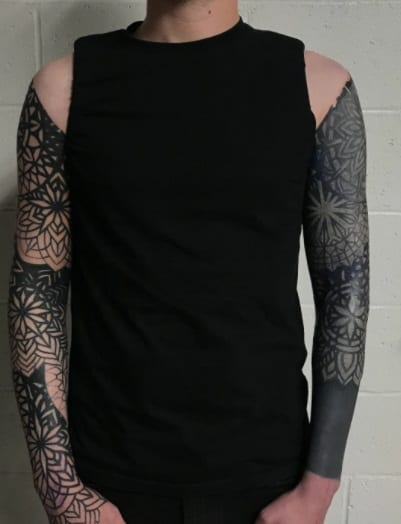
Blackout Tattoo Aftercare
Leave The Bandage Alone
Taking care of your new blackout tattoo is simple if it is done right, and it starts as soon as your artist finishes wiping down your fresh ink. Once you’ve had a chance to admire your tattoo in the shop mirror, your tattoo artist will usually apply a layer of tattoo gel or jelly over the tattoo and cover it with a bandage.
Although you may be tempted to take the bandage or plastic wrap off as soon as you leave the shop, you need to leave it alone for the first few hours after getting it done. Your artist should tell you how long to leave the covering in place and this length of time usually depends on where your tattoo is located and how big it is.
The reason you shouldn’t take the bandage off before the time is because it is actually protecting your ink from potentially harmful factors like sunlight, bacteria, and friction from your clothing against the open wound.
Wash Your Tattoo
Once you have safely removed the wrapping from your tattoo, you’ll need to clean it up. The first thing you’ll want to do is wash your hands, though, to prevent transferring any bacteria from your hands to your new tattoo.
Using a mild, unscented soap, you can then gently wash your tattoo with warm water. Be careful not to use fragranced soap, though, as this can irritate your tattoo and affect its overall healing. You should also take care not to scrub at the tattoo but rather to rub over it as softly as you can.
Once you have washed and rinsed your tattoo, you will need to pat it dry. Again, you will need to be careful not to rub the tattoo with a towel. Instead, try using a paper towel to pat it dry as carefully as you can. Once the area is dry, you will need to let it breathe for a while and avoid touching the area.
The First Week
While some tattoo artists may tell you to moisturize your tattoo after the first wash, others may advise waiting one or two days before adding a light layer of moisturizer to your skin. You should be sure to follow the care guidelines and instructions your artist has given you – after all, they will know what is best for your specific tattoo aftercare.
Your new tattoo may feel warm or seem slightly red in the first few days after getting your tattoo. This is normal and is just a natural part of the healing process.
In the first few weeks, you should try and avoid submerging your tattoo in water. This includes bathing or swimming. Instead, you should wash it gently in the shower and try not to get it wet other than when you are washing it.
Depending on how active you are and the environment you’re in, you can repeat the initial washing procedure as often as you need to within the first week. You should be careful not to exercise or strain the area too much during the initial healing stages, though, and try to keep it as clean as possible.
In the first few days, it is common to notice the formation of scabs over your tattoo. It’s crucial to avoid picking at these scabs or scratching the skin, as this can cause permanent damage to your tattoo. Mild swelling and redness usually disappear after the first week as well.
Week Two Of Healing Your Tattoo
During the second week, you will notice that the scabs will begin to flake off of your skin. Over the course of this week, it’s especially important to be cautious when cleaning and moisturizing because it’s easy to peel away scabs and harm your new tattoo.
It’s likely that your skin will be uncomfortable and irritated during the second week. You will need to keep in mind that you should try not to disturb the skin in any way, though, to keep your tattoo looking vibrant. If you are struggling to keep the irritation under control, you can always use an extra layer of moisturizer or an over-the-counter antihistamine like Benadryl to help alleviate the itching.
The Weeks That Follow
The final step of healing can be tedious and time-consuming. By this time, the majority of the bigger scabs will have peeled and dropped away. It’s possible that little scabs and patches of dead skin will develop. However, as the healing process progresses, these will subside.
Your skin can also appear dry and drab due to scabs and peeling skin, but you can ease these problems by regularly moisturizing the tattoo and keeping it out of the sun.
By the end of week three, the top layers of skin should be entirely healed, although it may take longer for the inner layers of skin to recover. But, because there are no open layers on the surface of the skin, there is less chance of infection, and you can let the inner layer of skin recover on its own.
It’s important to keep your tattoo well taken care of in the months following your tattoo appointment, which includes using sunblock on your tattoo if it is exposed to the sun. If you leave your tattoo unprotected, it can fade and turn dull over time, which negates the whole point of a solid black tattoo!
Conclusion
If you’re thinking of getting a blackout tattoo, whether it’s to cover up an old tattoo or simply because you like the aesthetic of it – it’s important to know how to look after it.
Solid black tattoos are more likely to be badly damaged by poor aftercare than others, so you’ll need to keep your routine up for at least six months after initially getting it done.



